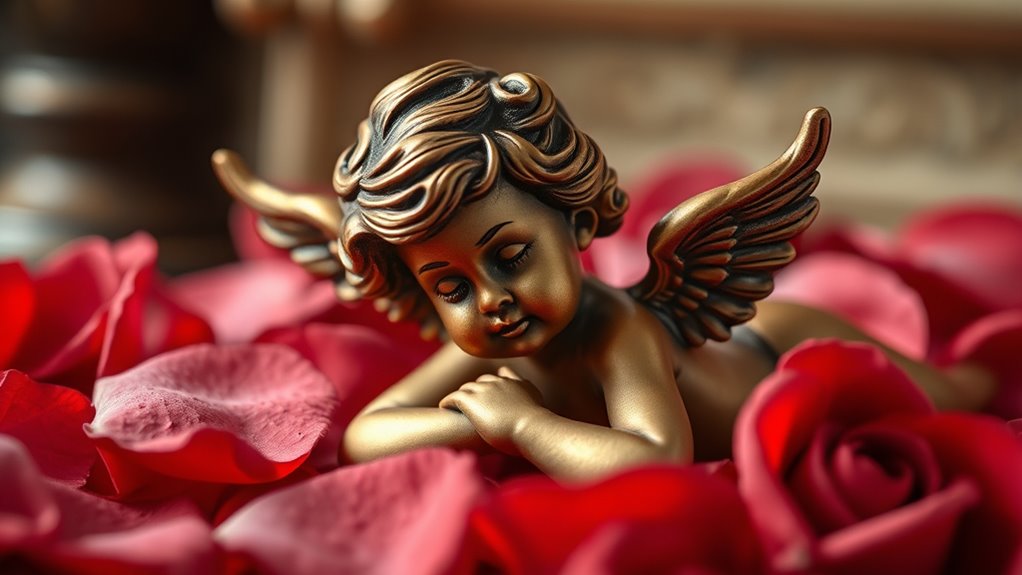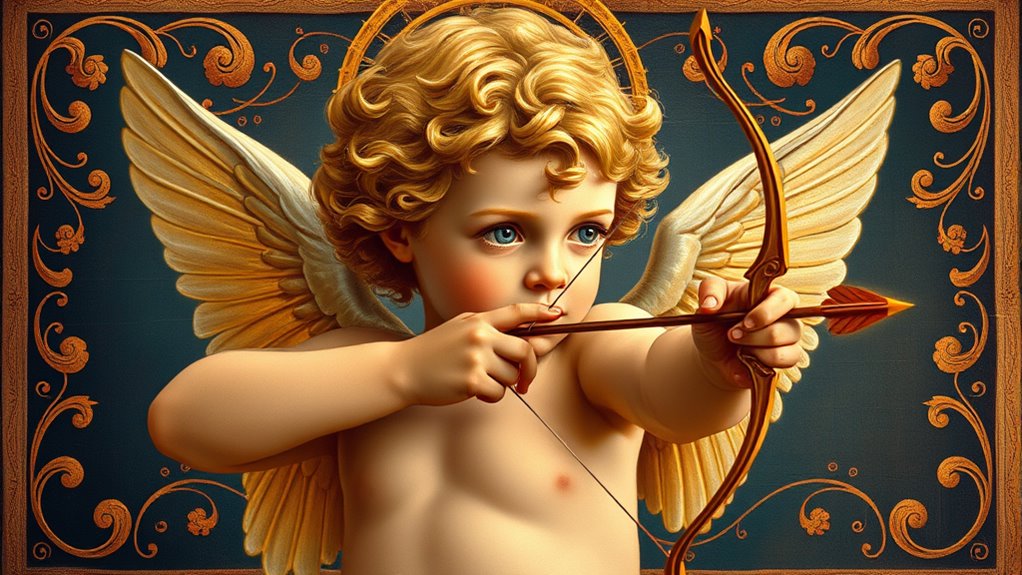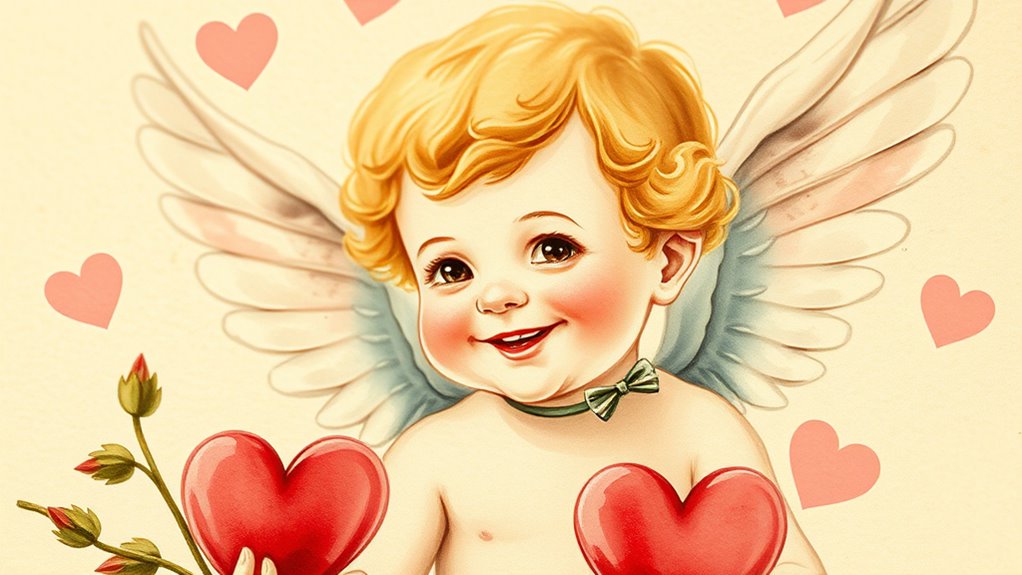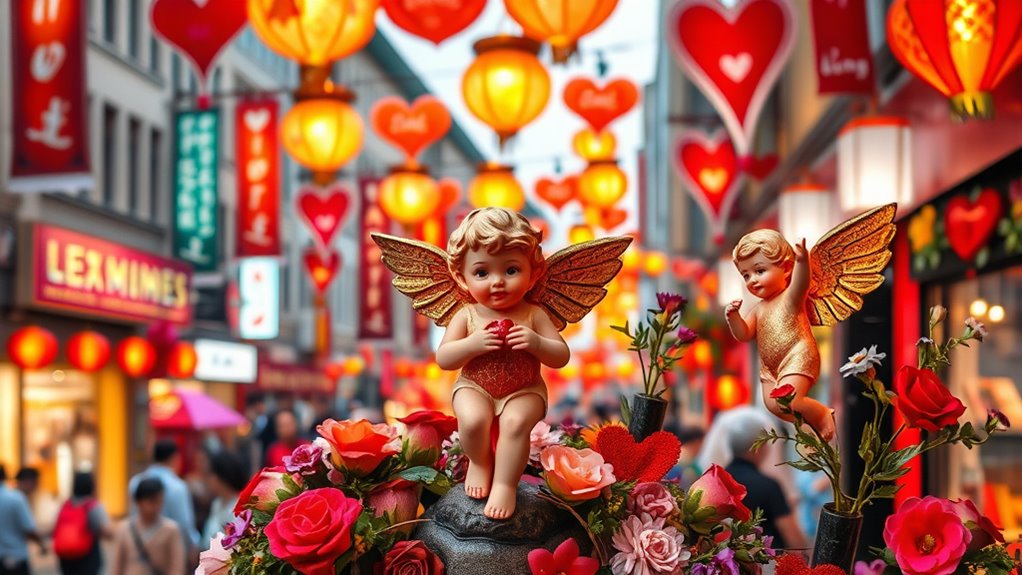Cupid became a symbol of Valentine’s Day through a long history of artistic and cultural shifts. Originally a playful Roman god of love rooted in Greek myth, his image softened during the Renaissance, emphasizing romance and desire. Over time, he transformed into a charming, innocent icon associated with love and Valentine’s traditions. Today, his image appears everywhere—from cards to celebrations—highlighting love’s joyful spirit. If you want to explore how this mythological figure became so universally beloved, keep going.
Key Takeaways
- Cupid evolved from Greek Eros, symbolizing love and desire, and was adopted by Romans as a divine love figure.
- During the Renaissance, Cupid’s imagery shifted to depict romantic, playful, and sensual themes, aligning with evolving cultural views.
- Artists and writers associated Cupid with love, attraction, and divine intervention, integrating him into Christian and pagan symbolism.
- Valentine’s Day popularized Cupid as a symbol of romantic love through literature, art, and commercial marketing efforts.
- Modern celebrations and media continue to depict Cupid as a charming, joyful figure, reinforcing his role as a universal symbol of love.
Origins of Cupid in Ancient Mythology

Cupid, known as the Roman god of love, has origins rooted in ancient mythology that date back thousands of years. You might not realize it, but he’s closely linked to earlier Greek myths. In Greek mythology, Eros, the god of love and desire, played a similar role. Over time, the Romans adopted and adapted Eros’s image, renaming him Cupid and emphasizing his playful, mischievous nature. You can find him depicted as a young, winged boy armed with a bow and arrows, ready to strike hearts with love. His stories often involve themes of attraction, longing, and the unpredictable nature of love itself. These mythological roots give Cupid a timeless, universal appeal, making him an enduring symbol of romantic affection.
The Evolution of Cupid’s Image Through Time

Over time, the image of Cupid has transformed considerably, reflecting changing cultural attitudes toward love and mythology. In early representations, he appeared as a youthful, playful winged boy armed with a bow and arrow, symbolizing innocence and divine intervention in love. During the Renaissance, artists depicted him as a mischievous imp or cherub, emphasizing his lighthearted and whimsical nature. In the 17th and 18th centuries, Cupid took on a more sensual and romantic appearance, often portrayed as a handsome youth, embodying desire and passion. Modern depictions blend these elements, showing Cupid as both a charming child and a romantic figure, illustrating love’s complex nature. These evolving images mirror society’s shifting views on romance, from divine innocence to personal passion. Additionally, the visual representations of Cupid have been influenced by artistic styles and cultural narratives, reflecting broader societal values about love and attraction. The symbolism behind Cupid’s arrows has also evolved, representing not only romantic love but also the unpredictable and sometimes mischievous nature of desire. Furthermore, the portrayal of Cupid has been shaped by cultural interpretations, which highlight how societal beliefs influence mythological imagery and its significance. The artistic evolution of Cupid demonstrates how mythology adapts to and reflects changing cultural perceptions over centuries. Effective use of trailer music techniques can capture this emotional complexity in visual storytelling, enhancing audience engagement with the narrative.
Cupid’s Role in Medieval and Renaissance Art

During the Medieval and Renaissance periods, artists frequently portrayed Cupid to symbolize love and divine intervention. You’ll notice how Renaissance artworks often depict Cupid with intricate details, emphasizing his role as a messenger of romantic and spiritual themes. These images also reflect deeper religious symbolism, blending Cupid’s playful nature with spiritual meaning.
Renaissance Artistic Depictions
In Renaissance art, Cupid frequently appears as a central figure symbolizing love and desire, reflecting the era’s fascination with human emotion and mythological themes. You’ll see him depicted as a playful, youthful boy often with wings, wielding a bow and arrow to pierce hearts with love. Artists like Botticelli and Titian captured Cupid in dynamic poses, emphasizing his mischievous nature and divine connection. These depictions highlight Cupid’s role in illustrating romantic attraction and the emotional complexity of love. You notice how artists portray him amid scenes of courtship, emphasizing his influence on human relationships. Through vibrant colors and detailed expressions, Renaissance painters bring Cupid’s lively, enchanting presence to life, reinforcing his significance as a symbol of love’s power during this transformative cultural period.
Symbolism in Religious Art
In religious art, Cupid’s presence often takes on layered symbolism that merges pagan mythology with Christian themes. Artists use Cupid to represent divine love, spiritual longing, or the soul’s desire for salvation. His playful, winged figure signifies the fleeting nature of earthly passions, reminding viewers of the contrast between mortal love and divine love. During the Medieval and Renaissance periods, Cupid appears alongside saints or religious scenes, emphasizing the harmony between human affection and spiritual devotion. Sometimes, he’s depicted as a messenger of heavenly messages, symbolizing love as a divine gift. This blending of pagan iconography with Christian symbolism reflects a deeper understanding of love’s spiritual significance, encouraging believers to see love not just as physical attraction but as a pathway to divine grace.
Transformation of Cupid Into a Romantic Icon

You see how Cupid’s image has changed over time, from ancient myth to modern romance symbol. His evolving symbolism reflects cultural shifts and artistic styles, shaping how we view love today. Exploring these transformations reveals how Cupid became the iconic figure of romantic affection we recognize now. Additionally, the depiction of Cupid in art often aligns with ethical representations, influencing public perception of love and desire. Furthermore, contemporary interpretations of Cupid increasingly incorporate AI-driven innovations, illustrating ongoing adaptations of his image in modern culture. Understanding these changes highlights the importance of cultural symbolism in shaping societal attitudes towards love and relationships. Recognizing the patterns in angel numbers can also deepen our appreciation for the symbolic evolution of love figures like Cupid.
Ancient Origins and Evolution
The transformation of Cupid from a mythological god into a romantic icon reflects centuries of cultural adaptation. Originally, Cupid was a mischievous, winged deity representing love’s unpredictable nature. Over time, his image softened and became more aligned with romantic ideals, especially during the Renaissance. This shift was driven by changing artistic portrayals and literary works that emphasized Cupid’s role as a symbol of love and desire. You’ll notice:
- His depiction evolved from a fierce, youthful warrior to a charming, innocent child.
- Artists emphasized his playful, affectionate qualities rather than his divine powers.
- The association with Valentine’s Day grew as Cupid’s image became synonymous with romantic love.
- The use of cultural symbols like Cupid can influence modern perceptions of beauty and love.
- Additionally, the rise of mass media and popular culture has further cemented Cupid’s status as a romantic icon in contemporary society.
- The enduring popularity of Cupid has been reinforced by cultural adaptations, ensuring his image remains relevant across generations.
- Modern depictions often incorporate mythological origins, blending historical context with contemporary symbolism to maintain his relevance.
These changes helped embed Cupid into the cultural fabric of love celebrations we recognize today.
Symbolism and Modern Depictions
As Cupid’s image shifted from a mischievous mythological figure to a symbol of romantic love, artists and writers began emphasizing his playful, affectionate qualities. You see him often depicted as a charming, winged boy armed with a bow and arrow, ready to inspire love. Modern depictions focus on his role as a romantic icon, highlighting tenderness and joy rather than mischief. His image now appears on cards, decorations, and jewelry, reinforcing themes of love and attraction. You might notice how artists portray him with a gentle smile or in tender moments, symbolizing the innocence and spontaneity of love. This transformation helps keep Cupid relevant today, reminding us that love can be playful, joyful, and lighthearted. Additionally, visual representations of Cupid often incorporate vibrant colors and soft lines, enhancing his appeal as a symbol of affection. The evolution of Cupid’s imagery reflects changing attitudes toward love, emphasizing its joyful and uplifting aspects. Incorporating aromatic imagery into modern love symbols, like scented candles or romantic diffusers, can evoke feelings of warmth and affection that align with Cupid’s spirit. Furthermore, the use of cultural symbolism has helped to deepen the connection between Cupid and contemporary expressions of love and romance. Recognizing the historical origins of Cupid enriches our understanding of his enduring significance.
The Adoption of Cupid in Commercial Valentine’s Celebrations

Cupid’s image has become a central figure in commercial Valentine’s Day celebrations, seamlessly blending ancient symbolism with modern marketing. You’ll notice how advertisers use Cupid’s playful and romantic imagery to sell everything from cards to chocolates. His presence appeals to emotions, making products more enticing and memorable. As a result, Cupid’s likeness is everywhere during this holiday, reinforcing love’s connection to commerce. This adoption has transformed Cupid from a mythological figure into a marketing tool. It’s not just about love anymore; it’s about creating a desire to buy. The commercialization of Cupid also demonstrates how cultural symbols can be repurposed to serve marketing objectives, further embedding his image in popular culture. Additionally, the widespread use of Cupid’s imagery has contributed to his status as a symbol of romantic love, which helps companies foster emotional connections with consumers during the holiday. Recognizing how cultural symbols are adapted for commercial purposes highlights the broader influence of creative practice in shaping consumer behavior. This phenomenon exemplifies how symbolic figures can be harnessed to evoke emotional responses that drive economic activity.
Modern Depictions and Global Celebrations of Cupid

Modern portrayals of Cupid continue to evolve, reflecting changing artistic styles and cultural influences around the world. In many countries, Cupid appears in vibrant, contemporary artwork, often blending traditional elements with modern design. You might see images of Cupid in colorful street festivals or digital media, where he’s depicted with diverse themes like LGBTQ+ pride or multicultural celebrations. Some cultures reinterpret Cupid as a symbol of universal love, emphasizing unity and acceptance. Additionally, wave and wind in coastal areas can influence how festivities and decorations are displayed, creating dynamic and lively environments. Globally, Valentine’s Day festivities often feature Cupid’s imagery in parades, decorations, and social media campaigns. These modern depictions keep Cupid relevant, connecting ancient mythology with current values of love, diversity, and inclusivity. Additionally, cultural reinterpretation of Cupid helps to reflect evolving societal attitudes towards love and acceptance, making his image more inclusive and representative of contemporary ideals. The symbolic significance of Cupid continues to adapt, illustrating how mythological figures can evolve with societal changes. You see his image everywhere, reminding you that love continues to be a universal language, and the modern depictions often incorporate digital art influences that appeal to younger generations.
Frequently Asked Questions
How Did Cupid’s Symbolism Spread Across Different Cultures Worldwide?
You’re curious about how Cupid’s symbolism spread globally. As you explore, you find that ancient Roman influences introduced Cupid as the god of love, and through trade, art, and cultural exchanges, his image traveled across Europe. Christian adaptations merged Cupid with Saint Valentine, broadening his reach. Over time, stories, holiday traditions, and popular media helped embed Cupid’s image into cultures worldwide, making him a universal symbol of love and romance.
What Are the Variations in Cupid’s Depiction in Non-Western Traditions?
Oh, sure, Cupid’s latest gig takes a global twist—no longer just winged cherubs. In non-Western traditions, you’ll see him as a mischievous boy, a playful spirit, or even a wise deity. For example, in India, Kamadeva wields a bow of flowers, while in Japan, similar figures embody love’s playful nature. These variations reflect diverse cultural stories, proving love’s universal yet uniquely flavored across the world.
How Has Cupid’s Portrayal Changed in Contemporary Pop Culture?
In contemporary pop culture, you see Cupid portrayed in many different ways. You might spot him as a playful, chubby cherub with a bow and arrow, or as a modern, stylish character in movies and ads. Sometimes, he’s shown humorously or ironically, reflecting how love and romance are celebrated today. These portrayals make Cupid more relatable and fun, keeping his image fresh and appealing across diverse audiences.
Are There Any Historical Controversies Surrounding Cupid’s Image?
Like a shadow lurking in the background, controversies surround Cupid’s image. Historically, some critics argued he promoted reckless love or outdated stereotypes, sparking debates about morality and representation. You might find it surprising, but in ancient times, Cupid’s mischievous or even violent portrayals clashed with more romantic ideals. These disagreements highlight how cultural views evolve, shaping Cupid’s image into the playful, affectionate symbol we celebrate today.
How Do Modern Interpretations of Cupid Differ From Ancient Ones?
Modern interpretations of Cupid often portray him as a playful, innocent, and romantic figure, emphasizing love’s joy and humor. In contrast, ancient depictions show him as a mischievous, sometimes unpredictable god who could cause both love and chaos. Today, you see Cupid mainly as a symbol of romantic affection, while historically, he embodied complex themes of desire, passion, and divine intervention, reflecting different cultural attitudes toward love.
Conclusion
Now, as you see Cupid’s wings spreading across hearts worldwide, it’s like watching a tiny, mischievous spark ignite a global fire of love. His story weaves through time, transforming from myth to mascot, guiding lovers with a playful arrow. So next Valentine’s Day, remember it’s not just about flowers or chocolates, but about the timeless symbol that reminds us love’s magic is as ancient as the stars and as fresh as a Cupid’s wink.









